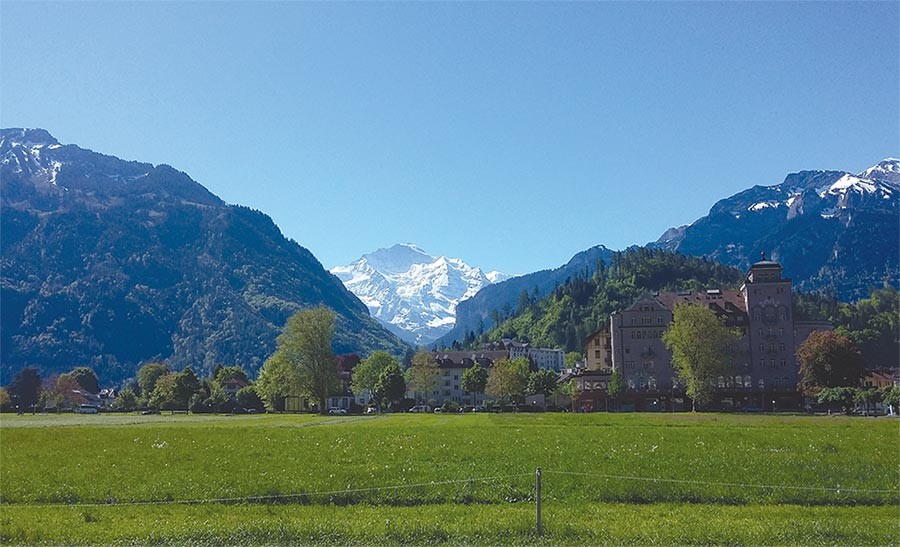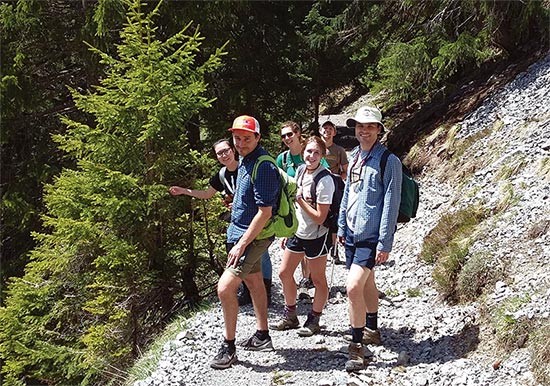
We were surrounded by mountains, some as high as 14,000 feet. It was May and snow was still to be seen on the summits. As we hiked upward, trees became scarcer and stunted, growing only very slowly. After a few hours of hiking along a well-maintained and well-used hiking path, we crossed the tree line and arrived at a lake, 20 acres in size and at an elevation of 7,431 feet, where we were able to enjoy breathtaking views of the surrounding mountains. We were at Bachalpsee, in the Bernese Oberland in Switzerland.
On this 2017 trip, I led a group of forestry and natural resources students and forest landowners on a 10-day journey to southern Germany and Switzerland. New England is at a latitude of 44 degrees, which is only about 2 degrees lower than the latitude of Switzerland. However, Switzerland is slightly warmer than New England, with average temperatures in the winter ranging from 28 to 45 degrees and summer temperatures of 65 to 82 degrees. Of course some of the high mountain peaks are covered by permanent ice and snow layers.
The Swiss Alps cover 65 percent of Switzerland. This means that, inevitably, many villages are clustered in valleys below these mountains. This means that in addition to lumber and habitat and all the other things forests are managed for, in Switzerland trees are also used to protect citizens from avalanches. A forest can’t stop an avalanche once it is rolling, but maintaining trees in areas where deep snow accumulates over the winter helps to stabilize the snow pack and prevent it from sliding downhill, thus reducing the risk.

While the mountains are much taller there, the forests in Switzerland are very similar to those found in the Northeast. About one third of the Swiss land area is covered by forest. Based on the most recent national forest inventory, approximately 58 percent of the trees in Switzerland are softwoods. Among the most dominant species are spruce (Picea spp.), European silver fir (Abies alba), and pine (Pinus spp.). The hardwood species are dominated by European beech (Fagus sylvatica), maple (Acer spp.), and ash (Fraxinus spp.). However, similar to the Northeast, ash dieback is causing the landscape to change. Whereas the ash dieback here is caused by the emerald ash borer, the loss of ash in Switzerland and other parts of Europe is due to an Ascomycete fungus (Hymenoscyphus fraxineus); as of 2017, an estimated 90 percent of ash trees were infected with this fungus and it’s expected that many of these trees will die.
European beech is similar in appearance to our American beech (Fagus grandifolia), but it is a different species. Both species are affected by beech bark disease, but beech in Europe seems to tolerate it better. Due to many more trees being healthy and free from beech bark disease, European beech can grow to respectable size – up to 115 feet tall and up to 5 feet in diameter. Larger trees have been reported, but are exceptions. These trees can also grow for 150 to 200 years, and trees up to 300 years of age have been documented. Beech wood is oftentimes used for pulp- and paper-making in Europe, but other products such as veneer, icicle sticks, tongue depressors, tooth picks, flooring, and toys are also very commonly made out of beech wood.
Beech is a shade-tolerant species and establishes well under a light canopy, where it grows rapidly. The resulting dark and shaded understory conditions generally prohibit other hardwood species from becoming established. European beech is an interesting species that, if not controlled and managed, would dominate the forest cover in Europe. Its natural range is from southern Sweden to Italy, west to France, Portugal, and Spain, and east to northwest Turkey.
Another economically important species in southern Germany and Switzerland is Norway spruce (Picea abies). In the Northeastern US, Norway spruce is occasionally grown as an ornamental tree, with some larger commercial plantations here and there. In central Europe, Norway spruce is the so-called bread-and-butter tree that can be found almost everywhere. It is fast growing and can reach 115 to 180 feet in height with a diameter of up to 5 feet. However, the tallest measured Norway spruce is 204 feet and grows in Slovenia with an estimated age of 230 to 300 years.
Norway spruce is used predominantly for lumber but also for pulp- and paper-making. Trees are often established in plantations, but they also regenerate naturally. The management goal with Norway spruce is to grow straight trees for lumber, but this goal is oftentimes challenged by wildlife. European roe deer (Capreolus capreolus), a small deer with a shoulder height of 2 to 2.5 feet and a weight averaging around 50 pounds, often browse Norway spruce. This may sound unusual, as our native white-tailed deer rarely touch spruce, but in Europe these deer can cause devastating damage to individual trees by eating the terminal leader, causing the tree to fork. Repeated browsing over many years will reduce the vigor and growth of young trees and thus can cause significant economic damage.
Forest managers and hunters in Switzerland are tasked with reducing and controlling wildlife populations, including roe deer. As we strolled along forest roads we saw wooden hunting stands every few hundred feet. Part of the job description of a European forester is to go hunting to control the wildlife densities, so it was not surprising to have all these hunting stands in state and private forests. Hunting in Europe is much different than it is in the US, with more stringent regulations and a smaller population of hunters. Besides hunting, forest managers frequently use seedling tubes to protect planted trees from browsing. Other measures include building temporary fences around plantations, and sometimes around naturally regenerated areas, to allow trees to establish.
Visiting Switzerland and southern Germany was an extraordinary experience for students and landowners alike. The nature is astounding and beautiful; the tall mountains of the Alps are breathtaking. The forests appear to be similar to our Northeastern forests at first glance, but provide enough differences to make for an interesting and educational visit.


